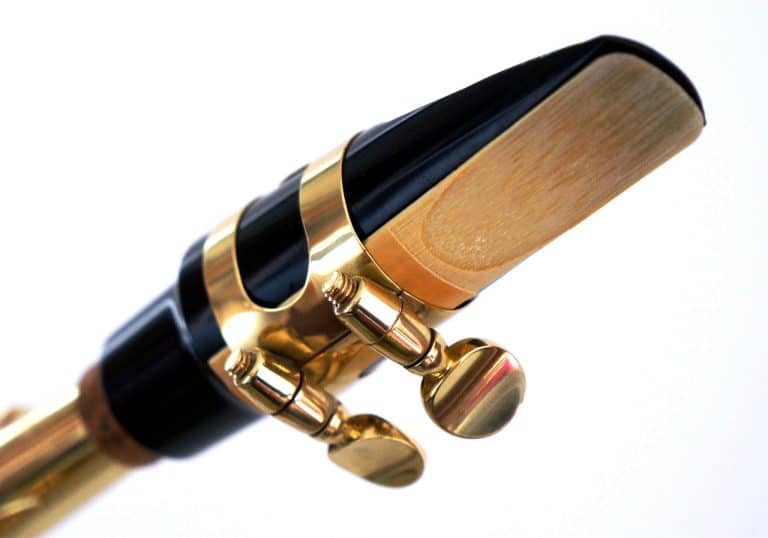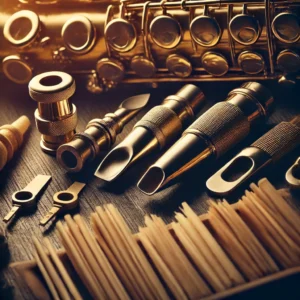
All About Saxophone Reeds and Reed Brands
What is the Saxophone reed?
The cane plant is used to make the reed. The hollow stem of the cane grows to full height in one year. To construct a reed, cane is cut to the appropriate length, then sliced along the length into four sections and shaved.
Because reeds are constructed of natural materials, no two reeds are identical. This is why it is critical to select the proper reeds for the finest sound. Take the time to learn how to properly select reeds.
Saxophone Reed Strengths
The strength of a cane reed is determined by its resistance rather than its thickness. A reed classified as a #2 has the same cut or strength as one labeled as a 3 or 4. In reality, the greater the number, the stiffer the material. The cane in this scenario. They build up the amount, or layers, of material in the case of a synthetic reed. The greater the resistance, the more difficult it is to move the reed with our breathing or air pressure.
Reeds are available in a variety of sizes, sometimes known as strengths. The amount of resistance a reed has determines its strength. Resistance is denoted by phrases such as soft, medium soft, medium, medium hard, and hard. Most manufacturers mark them by number, beginning with one for the least amount of resistance.
This makes it the most simple to play. That is, the least amount of resistance, which means it will be easier for you to get a tone out of your sax on the first try: one, one and a half, two, two and a half, and so on.
When you’re new to the saxophone and just getting started, a thin, or extremely soft, reed is preferable than a thicker, or harder, one to make the playing experience as comfortable as possible. A soft reed makes it easier to generate a sound; a stiffer reed makes it more difficult.
So Why Even Try Using a Harder Saxophone Reed?
Moving up from a 1 or 1.5 will help us acquire a better sound as we gain more playing expertise. No one with years of experience stays on a really soft reed like a 1 or 1.5. However, this does not imply that the harder the reed you play, the better the sound.
As your embouchure strengthens, you’ll be able to try going up a half size. It’s all incredibly personal and unique to each person. There are some well-known professionals who play on a 2 or 2.5 reed. The amount of reed strengths does not correspond to your playing ability. You’ll gradually progress over the first few years, eventually settling on a size that remains your favorite strength.
It can be like trying to find the appropriate size shoes to buy… One type or brand may not be identical to another, and depending on the manufacturer or the material, you may need to move up or down a half strength.
The Reed Must Be Wet
When your reed is dry, never try to lay it on the mouthpiece. This is an excellent method for obtaining squeaks. However, a dry reed will not be able to perform as well as it should in order to assist you in producing your tone. You can either place it in your mouth to absorb saliva or place it in a glass of water for several minutes.
Water should cover the entire vamp of the reed all the way up to the stock. When a reed dries out, it warps, thus playing it this way wouldn’t be very effective until the warping was removed. When it’s wet and you play it for a minute or two, the warping will go away. Place it in a reed guard or firmly on a hard level surface to prevent warping.
How To Tell If a Reed is Good or Bad
Visual inspection can reveal this information. The first step is to examine the reed’s center, or “heart.” It should be black in color and at the middle of the reed. Because reeds are composed of cane, the grains run longitudinally. Inconsistency and discoloration in the grain may indicate that it isn’t a good one. The center should be the heart. Having said that, it is conceivable for a reed to have uneven grain and a heart that isn’t in the center and still play beautifully.
Personally, I’m not concerned with the appearance; I just slap it in place and it either works or it doesn’t. I believe people first became interested in reeds when they purchased them as singles from a package of 20 or so. However, because stores no longer allow you to cherry select them, a visual evaluation is no longer as vital.
How Will I Know When To Change The Reed?
Natural cane reeds have a shelf life. It can be either short or long depending on the quality and duration of use. This quantity of good playing time can range from a few days to a few weeks or even months. A more expensive premium reed may survive longer in this situation. Most cane reeds are stiff right out of the box. After a while, it will begin to feel natural. This sensation begins to shift, becoming softer and weaker almost abruptly. The reed is now telling you that it is time.
Rotating Your Reeds
Some musicians will switch out reeds. This is an excellent idea because when your favorite reed wears out, you’ll have another one already broken in and ready to go. If not, you’ll be playing on a brand-new reed that may be stiff for a day or two.
Don’t Buy One or Two, Always Get a Box
Because cane reeds are so uneven and unexpected, you might only get a few decent ones in the package. Let’s say you only get a few reeds (some retailers would break a box and sell singles) and they’re bad. When you go home, your entire reed collection is in disarray. But you don’t realize they’re horrible since you’re just getting started. Now you’re blaming yourself, feeling bad, and definitely ready to give up!
After playing through a complete box of 10 or 20, you’ll notice a difference between the easier and more
Begin with a very soft 1 1/2 reed and see how it feels. If you’re still having trouble getting a sound, try a 1.
Saxophone reeds are the kind of item you have to decide for yourself, especially as you progress. There is no such thing as the world’s best reed. What works flawlessly for one person may not work for another. Each of us has distinct factors like as embouchure, mouthpiece tip apertures, and so on.
You’ll eventually want to try a few different brands and strengths to see what works best for you.
A Few of the Most Popular & Well-Known Saxophone Reed Brands
Here are a selection of the most well-known saxophone reeds. Most people, including myself, would recommend the standard Rico reed for somebody just starting out on the saxophone. They’re not the best quality, but they’re consistent (as consistent as a cane reed can be) and adequate for playing until you establish a pleasant tone. To be honest, you don’t need to buy the most costly reeds when you first start out because you won’t notice the difference.
Rico
The Rico reed was the first one I ever used. It is most likely the most well-known and largest reed maker. When beginning off, I strongly advise any beginner to use a very soft Rico. I’m talking about a 1 or 1 1/2. It’s ideal to keep these two sizes on hand so you can test which one feels the best to you. A poor or incorrect reed strength might seriously inhibit your progress, especially at this early period.
Rico offers various options, including Rico Royal, Rico Jazz Select, and D’Addario, but stick with the standard ones until you’ve gained some control over your tone.
LaVoz
LaVoz, like the Rico brand, has been around as long as I can recall. Although many of the guys I know enjoy and use these reeds, I never remained with them for very long. They’re good reeds, but I recall them not being as good right out of the box as the Rico’s. However, once they’ve been broken in, they should last longer than the Rico’s.
Vandoren “Java”
While they are the nicest reeds I’ve ever used on my Guardala mouthpiece, I wouldn’t necessarily continue to use them if I switched mouthpieces. If you’re considering purchasing a Guardala mouthpiece, you should try these reeds first; otherwise, stick to one of the other brands, another Vandoren V16, or ZZ’s. Vandoren produces high-quality reeds.
Reed Guards
These are essential and are available in a range of styles and brands. They function to safeguard your reeds because they need to be held firmly on a hard, flat surface after being soaked and used so they don’t distort.
These guards are essentially just a hard flat surface with a mechanism to keep them firmly in place. If you don’t want to spend the money, you could construct one out of a small piece of glass or a hard flat piece of plastic and wrap a rubber band around it. These are reasonably priced, with the one featured here costing around $15 and smaller ones costing around $5.
If you live in Canada, go to Amazon.ca.
Synthetic Saxophone Reeds
As someone who has played on cane reeds for decades, the idea of picking up a reed, putting it on the mouthpiece, and having it respond flawlessly every day for months and months seems too good to be true. Fortunately, this is now a reality thanks to the development of some excellent synthetic reeds.
After coping with the unpredictability and expense of cane reeds, it’s a natural development to consider, if not completely replace, synthetic reeds. Sales are increasing since more and more players are doing this.
Synthetic reeds (sometimes known as plastic reeds) have gone a long way in recent years. Personally, I had never been able to play one until last year. More and more manufacturers are entering the fray, which is excellent for all of us. I genuinely believe that a nice synthetic reed is the way to go for a beginner. Every day, you’ll get a regular, dependable reed.
With inexperience and only beginning on the saxophone, there are simply too many other variables to contend with. So, if you can solve one of the most serious issues we have with saxophone playing, go ahead and do it!
What Are Synthetic Saxophone Reeds Made From?
Natural reeds are created from cane, but what about synthetic reeds? All of these reed makers are striving to emulate a cane reed in their products, and each of them has their unique method of doing so using a range of materials. Polymer compounds, both natural and manufactured, are employed.
Silk, wool, paper, wood fibers, and even natural rubber can be used to create natural polymers. Also used are plastic polymers generated from chemical substances. These polymers are not limited to the reed industry; they are also utilized in the manufacture of automobiles, plastic parts, carpets, and a variety of other everyday products.
Synthetic Reeds for the Total Beginner?
If you’re just starting out on the sax, the greatest thing you can do is get a soft synthetic reed. If you’re just starting out and have a few fresh cane reeds that all suck, you’re not sure if the lack of sound is due to you or your reed.
A box of standard cane reeds may include 10 or 20 reeds. That is not to say they will all be successful. A few will be excellent, a few will be adequate, and a few will be discarded unless you are ready to work on them. One of the issues with traditional reeds is this.
Working on Reeds to Make Them Play Better
Reed Rush is a natural substance that has been used for many decades. It is a plant that grows near water.
It has rib-like edges and becomes hard enough to wear down the reed as it dries out from its typical living green form. This is solely applicable to cane reeds.
You can also sand down a reed with fine sandpaper. There is also a tool available for purchase called The Reed Geek, which works well on synthetic reeds.
What Are Some Of The Synthetic Reed Brand Names?
Rico began with a “plastic wrapped” reed in the 1980s. This was not a fully synthetic reed, but rather a conventional cane reed with a thin black plastic coating. The objective was to add an extra layer of protection and extend its lifespan.
Fiberreed offers four main types of reeds – Natural, Carbon, Hemp, Onyx.
Legere was the first 100% synthetic reed we heard about and tried. It was made in Canada.
Forestone are a type of white bamboo synthetic reed made of polypropylene resin and cellulose wood fiber.
Bravo are sold differently than other brands since they come in boxes of five, whilst the others are sold individually. Bravo’s box of 5 reeds costs around the same as a single premium reed from the other manufacturer.
Bari, we assume this is the same firm that produces mouthpieces. The reeds are far less expensive than most other brands and only available in one model.
Fibracell is another well-known brand from the United States. They are a hit or miss depending on the mouthpiece and even the day.



